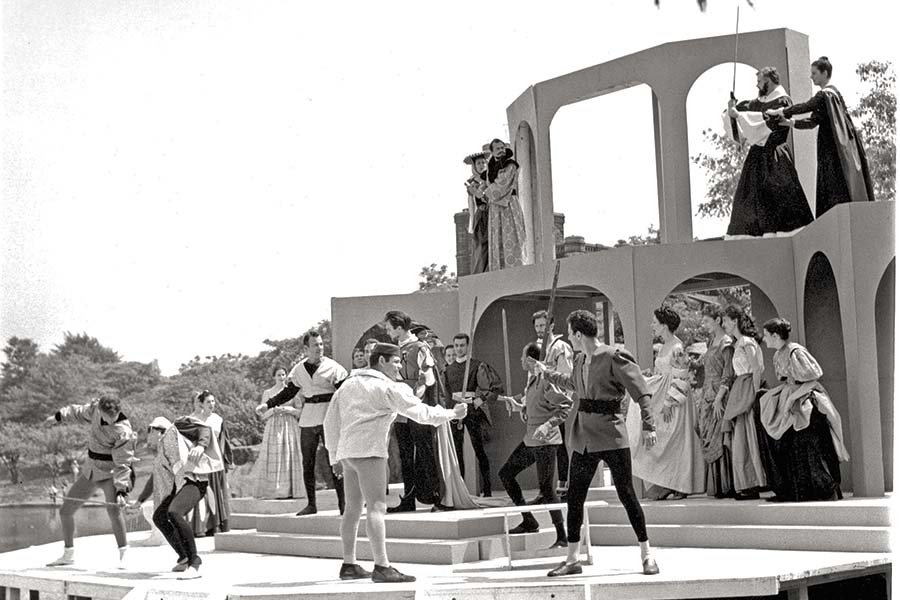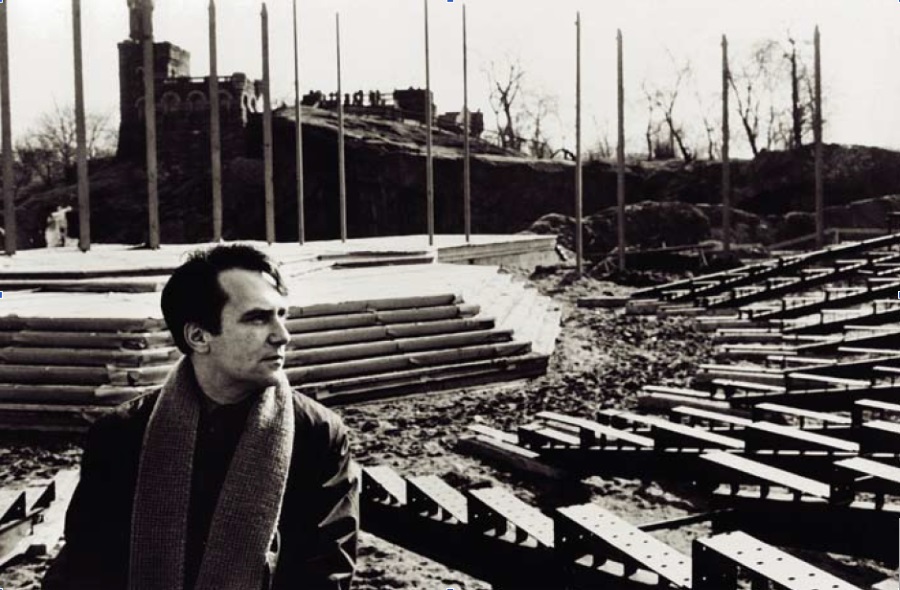The stories told by America’s nonprofit theatres aren’t just the fictions that playwrights and actors put onstage but the grants these organizations write, the mission statements they publish, the budgets they create, and the material facts of how—as well as with and for whom—they make their work. These latter stories aren’t just the stuff of brochures and board meetings; they constitute the very mythology of why people make theatre in the first place, and how even many casual theatregoers think of the art form.
The Steppenwolf story is one such powerful legend: A troupe of youngsters puts on plays for nothing in a church basement and builds an audience, including the leading local critic, until they’re a national brand with their own ensemble aesthetic. There are endless variations on this Little Troupe That Could template, from South Coast Rep to East West Players. Other U.S. theatres have kicked off with grand ambitions from the jump, like the Guthrie or Arena Stage, or have been created by city leaders to be their own homegrown versions of this model, like Trinity Rep or American Conservatory Theater. Others start self-consciously small and grass-roots by design and are designed to stay that way, whether it’s the on-the-ground ethos of El Teatro Campesino, the experimental laboratory approach of the Wooster Group, or a culturally specific incubator like Negro Ensemble Company.
But I would argue that the narrative that underlies much of the 20th-century regional nonprofit theatre movement, perhaps paradoxically for a national trend characterized by its pointed defiance of New York-centric theatre culture, had its origins in New York City. Yes, I’m talking about Joseph Papp, the founder of the New York Shakespeare Festival and the Public Theater, the subject of Joe Papp in Five Acts, an elegant, illuminating documentary that will begin airing on PBS today, whose driving vision of art as a social good in itself, accessible and relevant to any and all, is the very air that the U.S. nonprofit theatre field breathes (though there are strong countervailing winds). For among the many things this feisty, indomitable leader recognized was that New York City’s five boroughs were as under-served by the arts of his time as any rural community, and that his city’s diverse populations needed and deserved theatre as much as its moneyed elites. At his best, and until he had his head turned by the mixed blessings of Broadway success, Papp—first at various makeshift venues, then with a mobile Shakespeare truck, and finally at both Central Park’s Delacorte Theatre and at the multi-venue civic palace of the Public in the East Village—was making regional theatre for a region that happened to be New York City.
Because it was New York, of course, his example had national influence, and has seeped into the soil of every budding company of any size or aspiration whose members go hat in hand to civic and corporate funders, not to mention audiences and critics, to make a case for their art’s unique intrinsic value outside the reign of the market. And precisely because we take the Papp example for granted, Joe Papp in Five Acts arrives at an opportune time to remind us what all good history sets out to capture: More than simply memorializing names and lore, it gives us a powerful sense of contingency and indeterminacy, imparting the lesson that the way things turn out, and could still turn, is never foreordained but comes about due to a fortuitous combination of vision, luck, and sweat.
Made by Tracie Holder and Karen Thorsen, Joe Papp in Five Acts feels, appropriately enough, like a time capsule from another age, not only because of the decades of archival footage it contains, but also because it was in fact made in 2010 and had its premiere at the Tribeca Film Festival in 2012. So while many of its interviewees are still very much with us (Christopher Walken, Meryl Streep, Martin Sheen, James Earl Jones), it’s striking how many are not (Roscoe Lee Browne, Olympia Dukakis, Lawrence Levine, Lee Breuer).
Divided into its various “acts” with readings from Shakespeare by Kevin Kline and others, the film makes the case for Papp himself as a kind of Shakespearean figure, or perhaps something out of Dickens. The child of poor Jewish immigrants, Papp, nee Papirofsky, was a street-smart Brooklyn scrapper as ashamed of his parents’ poverty as he was consumed by ambition for something more. Exposure to culture via the public library and the phonograph whetted his appetite, but it wasn’t until Navy boot camp and a G.I. Bill-subsidized jaunt in Hollywood with the Group-derived Actors’ Lab company that Papp found his true métier: as a savvy point man who could and would do all the producerial and administrative tasks no one else either could or wanted to, least of all a bunch of fractious, sensitive artists.
But where others might have parlayed those valuable skills into a lucrative career in Hollywood or on Broadway, Papp, as fueled by the left-wing class politics of his youth as he was inspired by the theatrical canon, applied his formidable organizational talents to an artistic project that was for its day a unique fusion of bottom-up street politics and populist public art. To a degree that remains remarkable—and this comes through powerfully both in Joe Papp in Five Acts and in Kenneth Turan’s indispensable oral history Free for All—Papp insisted with maniacal purity on a singular vision of art for the people, and he wouldn’t compromise. “A quarter would be too much,” he said when pressed on his no-cost admission policy. The notion of doing Shakespeare for free in a public park, in accessible productions with American accents and multiracial casts, is now such a commonplace of U.S. culture that it’s easy to forget what a radical and counterintuitive idea it really was in the 1950s. And we can too readily gloss over the huge obstacles that stood in the way of such a vision, from garden-variety cultural snobbery to the sheer logistical and economic lift of launching and sustaining such an ambitious project in an expensive, patronage-clogged metropolis. The documentary details Papp’s high-profile David-and-Goliath row with the notorious civic macher Robert Moses. Moses ostensibly opposed Papp’s free-ticket policy on economic grounds, though really what we can hear, in a withering TV clip of Moses, is the familiar voice of the status quo saying, “This isn’t the way things are done here.”

Indeed, if Papp had had a theme song, I’d nominate “Everybody Says Don’t,” especially the lyric, “But I say do.” One theme of Papp’s life, and a question it raises for us in an age of long-overdue artistic turnover at many U.S. theatres, is what kind of personality it took to pull off his remarkable civic and P.R. feats, and whether the hard-driving, married-to-the-job approach he brought to his life’s work is a sustainable, let alone admirable, leadership model. There is no question that Papp’s won’t-take-no persistence served him well when he butted heads with the city establishment and deep-pocketed elites, and bucked general public indifference. And his singular passion inarguably led to the strong artistic relationships he forged with authors like David Rabe and David Hare, among others—a group of brash young men composer Elizabeth Swados laughingly calls “the Davids,” in a gentle criticism of the often macho atmosphere that pervaded the institution. But that hot-burning fire was also the reason for the harsh breakups of so many of those formative bonds. And once empowered by a multi-million-dollar institution and decorated with Tony Awards, a cigar-chomping street fighter can start to look like any other showbiz bully.
Still, at so many turns, Papp’s instincts for the bold, distinctive move no one else would have the chutzpah to make were eerily preternatural: staging Hair as the Public’s first production in 1968; moving such unlikely properties Rabe’s edgy Vietnam War satire Sticks and Bones or Ntozake Shange’s Afro-feminist choreopoem for colored who have considered suicide/when the rainbow is enuf to Broadway; seeing the gold in Michael Bennett’s nascent idea for A Chorus Line, then cashing it out, in a possibly Faustian showbiz bargain that has had complex implications for the Public, and the larger field, ever since; producing Larry Kramer’s coruscating The Normal Heart before AIDS had reached its deadly peak; turning down NEA money in 1990 because it would come with a “no obscenity” clause attached—a quasi-loyalty oath Papp would have recognized as a sinister echo of the time he’d lost a job at CBS during the HUAC blacklist. That he won that job back (then left it soon after) was the key takeaway: He had faced down the impossible and won the day because he didn’t blink, so he kept doing that.
Until he couldn’t. The documentary gingerly handles the final chapters of his life, when his autocratic impulses had driven away as many or more than were attracted to his embrace. Words like “brutal” and “minor fascist” come up. And the film movingly captures the almost unbearably painful coincidence of his demise: Diagnosed with prostate cancer around the same time his son Tony was diagnosed with AIDS, Papp died within months of his son’s passing in 1991, at ages 70 and 29, respectively. By most accounts, in those waning days he made amends with many estranged associates, including his trusted consigliere, Bernard Gersten, whom he’d consigned to oblivion in part, perversely, because Gersten had secretly master-minded a surprise birthday party for Papp in 1978.
This ending gives Papp’s life a dramatic, even tragic shape, and speaks to the thorny complications of a man who, as David Hare puts it, was “more interested in possibility than in accomplishment.” Swados spells it out with typical clarity: “The thing that made Joe great was the fact that he was so flawed and that he reached so high, and in that way he was like the Shakespeare characters he loved so much.”
Leaving aside whether we want to continue to live in a theatre field run by men with these kinds of flaws, Shakespearean or otherwise, it is worth remembering, again, that there was nothing inevitable about Papp’s achievements. He may have felt called by destiny, at least occasionally, but he was improvising on the fly more than he was master-planning. The salutary lesson we can take from Papp’s example is to fight now, tenaciously, for the ideal theatre we want to see. What is the radical idea that is today’s equivalent of free Shakespeare in a public park? That’s what a 21st-century Joe Papp would be looking for.
In short, the highest tribute we can offer to the revolutionaries of the past is to dream, as they did, beyond the given circumstances of the current moment, and to fight for a future that’s better than the past bequeathed to us. That’s what we can see in Joe Papp in Five Acts if we look for it.
Rob Weinert-Kendt (he/him) is the editor-in-chief of American Theatre. rwkendt@tcg.org


